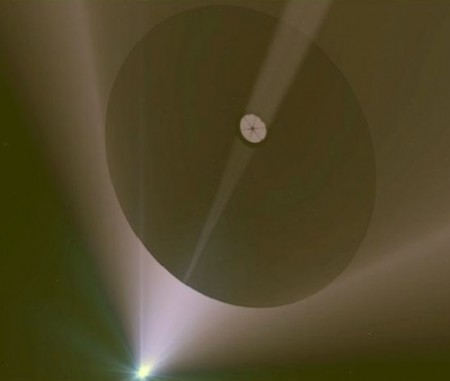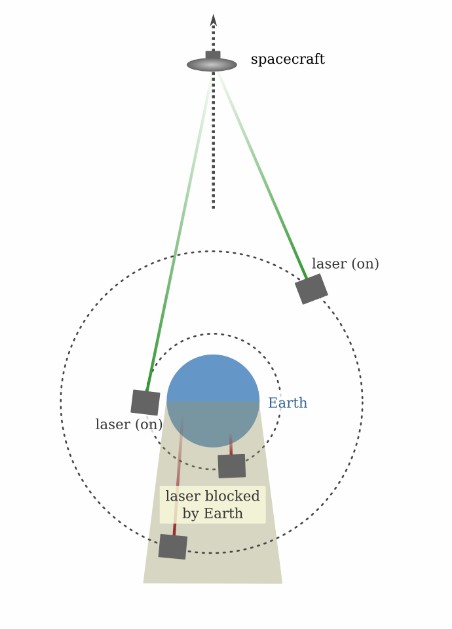February 24, 2016 – Back in April of last year, a UC Santa Barbara physics professor, Philip Lubin, proposed a faster method of propulsion that could conceivably get us to Mars in a few days and to the nearest star in 15 years. But to do this Lubin stated we would have to make “a fundamental change in our thinking of both propulsion and in many cases what a spacecraft is.”
What he describes is a propulsion system using a photon driver beaming energy to push a range of technologies from wafer thin micro-satellites, to 100 ton human carrying space capsules. Directed energy technology is still in its infancy. It is as far removed from chemical rocket technology as is the horse and buggy to jet aircraft. Its only limit is the speed of light. To make it operational you need a very intense light source such as a laser. You don’t need a big rocket engine and tons of chemical fuel pushing a payload into and through space.
A proof of concept photon driver consisting of a laser phased array could conceivably be used to demonstrate the technology for deploying micro-satellites. By adding a laser sail to the payload one could achieve more than 1/4 light speed in 10 minutes, reach Mars in 30 minutes and Alpha Centauri in 15 years. That same array could drive a 10,000 kilogram payload to speeds of 1,000 kilometers per second. Lubin proposes a CubeSat test to prove the feasibility of the technology.
He states, “useful testing can begin at the sub kilowatt level…there is no intrinsic barrier to the speed, except the speed of light.” His laser photon driver could be used repeatedly launching hundreds of small payloads per day or a few large payloads per week.
When NASA speaks of photon propulsion in the conventional sense it always involves an on board thruster-based technology such as the Evolutionary Xenon Thruster or VASIMIR. These technologies either harvest fuel from the near vacuum of space, form solar particles, from converted sunlight, or carry a fuel payload on board that gets cooked and spewed out the back end of the spacecraft. Such propulsion technologies are capable of achieving relatively high space velocity but do it over periods of months. NASA has even considered using photonic laser thruster systems by parking an energy source in orbit to push satellites into deeper space.
Using Lubin’s proposed technology a 100 kilogram spacecraft (about the size of one of the Voyagers) could be propelled to 1.5% of the speed of light or nearly 300 times faster than the propulsion technology that pushed Voyager to the edge of the Solar System over the last 37 years. That 100 kilogram spacecraft would reach Mars in a day. A Space Shuttle sized vehicle propelled in this fashion would reach 780 kilometers per second, 46 times faster than Voyager and 0.26% the speed of light.
A test system could be built from the size of a desktop to large platform. Modest-sized systems could be ground or balloon based. Large laser propulsion systems could be compiled from a group of smaller units and arrays. The technology could serve to push out near-Earth orbital debris. It could also be deployed as a planetary defense against near-Earth asteroids (NEOs).
The proposed laser sails that would accompany satellites deployed this way would be different from current solar sails requiring highly-reflective surfaces. The technology to produce such highly reflective coatings already exists for extruded plastic and fiber-optic quality glass. Metal-plastic film may prove to be the best material choice.
Beam targeting and shaping will be critical to ensure stability in the initial guidance of a spacecraft from Earth-based or low-Earth orbit launch to targeted destination since there will be no on board means of correcting a navigation error. But when you consider the complexity of orbital mechanics today that allows us to send spacecraft in elliptical gyrations around the Sun to get from point A to point B for planetary, comet and asteroid missions, it would seem that directed energy propulsion would prove far simpler with straight trajectories and very high speeds. And if you could send many small payloads daily into space this way knowing that the target such as Mars can be reached in as little as a day, it would seem that adjustments could be made in the beam’s guidance should one micro-satellite miss.
What you gain in speed you lose in maneuverability. For human crewed spacecraft that is a significant problem. Getting to Mars in a day is nice but slamming into the planet is not a desirable outcome. For large payloads with humans aboard, therefore, the spacecraft would have to include local guidance and an on board propulsion system to allow for deceleration, orbital insertion and descent to a planet surface.
Lubin, in addressing this issue in his paper, acknowledges the difficulty and suggests that early missions using directed energy propulsion be limited to fly-by.
He also considers using the technology for long range interstellar communication in which the technology on board the spacecraft would include a laser transmitter capable of returning images and data at acceptable streaming rates, even suggesting we might be able to see high-definition video streamed back to Earth from nearby interstellar neighbours.
Another implication for the technology described in the paper is its use as a beacon to signal other space civilizations that we exist. We could also use it for SETI searches of nearby planetary systems.
All in all what Lubin is proposing is a faster step to the stars. Sounds like it’s worth further study and maybe even a pilot project or two.





















Possibly this could help a satellite accelerate away from the Earth – say from Low Earth Orbit to maybe Lunar distances. It would be interesting to calculate the beam density at the orbit of the Moon, could it be enough to accelerate even a light spacecraft?
I cannot imagine that a laser could still accelerate a spacecraft which was even 1/2 way to Mars – the density would have to be very slight by that distance.
If we could manage to find a location for the laser it might be worth a trial, but locating such a laser would be very tough. It could be on a mountain top – as long as we could spend billions getting high voltage power lines up there. It could be in space as long as we could overcome public opposition to launching a nuclear power source into space.
I don’t believe Lubin’s hypothetical system would require the billions you are suggesting for a pilot project.
I do not have time to do any calculations but almost certainly the beam density would “fall off” so steeply that a very simple demo is all that could be done. For a real demo you would need a high powered laser. From where would you fire even a single full power laser beam?
If you figure the cost of putting a powerful laser on the only possible place – a mountain top – it would cost a billion dollars. First every tattooed demonstrator would block construction. Then you would have to extend high voltage power lines. Then you could start on building a facility that would rival the Thirty Meter Telescope in cost and complexity.
So you could demo the system with the existing low power lasers but it would be very costly to scale it up.
Sigh.
Just how massive are the directed energy systems going to be? Can’t you mate them to a manned nuclear spacecraft ? It would only need travel up to an acceleration of 6 G’s.
Hi Harlan, I refer you to the original documentation describing the technology at: http://www.deepspace.ucsb.edu/wp-content/uploads/2015/04/A-Roadmap-to-Interstellar-Flight-15-d.pdf. The author proposed a small test system to start but argues it is scalable starting with power per mass at 5 kg/kw with the size of a 1 kw amplifier no bigger than a textbook. He goes on to state the “laser system can be built and tested at any level from desktop to extremely larger platforms.This is radically different than the older “use a huge laser” approach to photon propulsion.This is the equivalent to modern parallel processing vs an older single supercomputer.”
[…] approaching one-quarter the pace of sunshine. You possibly can learn extra about this know-how in a posting I wrote again in February of […]